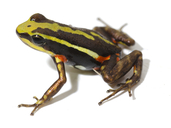|
Epipedobates tricolor (Boulenger, 1899)
Phantasmal Poison Frog, Phantasmal Poison-arrow Frog | family: Dendrobatidae subfamily: Colostethinae genus: Epipedobates |
 © 2017 David C. Cannatella (1 of 1) |
|
|
|
Description Description: E. tricolor has a snout-vent length of approximately 22.6 mm (Hermans et al. 2002; Silverstone 1976). The skin is smooth all over the body. The projecting snout is truncate. The nostril is closer to the snout than the eye. The canthus rostralis is angular and the loreal region is vertical. A distinct tympanum is present (Boulenger 1899). The second finger is shorter than the first. Toes are basally webbed (Silverstone 1976). Coloration: The ground color is usually dark red to brown. Three yellow-white stripes are present on the dorsum (Forsman and Hag 2006). The venter has black or brown marbling (Silverstone 1976). Hind limbs have bright red spots (Duellman and Wild 1993). Variation: Individuals can be identified by their stripe patterns which vary (Hermans et al. 2002). Distribution and Habitat Country distribution from AmphibiaWeb's database: Ecuador
It inhabits leaf litter on the forest floor and in wetlands (Forsman and Hag 2006; Stuart et al. 2008). Life History, Abundance, Activity, and Special Behaviors Male to male aggression is present in the species. Both males become erect, with front legs facing outward. The males will clutch one another, while standing up straight. They then circle each other until one can gain the upper hand and force the other to the ground, by laying on him (Hermans et al. 2002). This species is oviparous. The clutch size is about 10 eggs. Males care for eggs in leaf litter, then carry tadpoles on their backs to be deposited in water (Forsman and Hag 2006). Its diet consists of small insects (Forsman and Hag 2006). Trends and Threats Relation to Humans Possible reasons for amphibian decline General habitat alteration and loss Comments E. tricolor and E. anthonyi were recently separated from one another (Stuart et al. 2008). E. tricolor produces a toxin that includes epibatidine, which is an alkaloid (Gomez-Sanchez et al. 2007).
References
Boulenger, G. A. (1899). ''Descriptions of new reptiles and batrachians collected by Mr. P. O. Simons in the Andes of Ecuador.'' Annals and Magazine of Natural History, 7(4), 454-457. Duellman, W. E., and Wild, E. R. (1993). ''Anuran amphibians from the Cordillera De Huancabamba, Northern Peru: systematics, ecology, and biogeography.'' Occasional Papers of the Museum of Natural History, The University of Kansas, 157, 1-28. Forsman, A., and Hagman, M. (2006). ''Calling is an honest indicator of paternal genetic quality in poison frogs.'' Evolution, 60, 2148-2157. Gomez-Sanchez, E., Soriano, E., and Marco-Contelles, J. (2007). ''Synthesis of 7-Azabicyclo[2.2.1]heptane and 2-Oxa-4-azabicyclo[3.3.1]non-3-ene Derivatives by Base-Promoted Heterocyclization of Alkyl N-(cis(trans)-3,trans(cis)-4-Dibromocyclohex-1-yl)carbamates and N-(cis(trans)-3,trans(cis)-4-Dibromocyclohex-1-yl)-2,2,2-trifluoroacetamides.'' Journal of Organic Chemsitry, 72, 8656-8670. Hermans, K., Pinxten, R., and Eens, M. (2002). ''Territorial and vocal behavior in a captive dart-poison Frog, Epipedobates tricolor Boulenger, 1899 (Anura: Dendrobatidae).'' Belgian Journal of Zoology, 132, 105-109. Silverstone, P.A. (1976). ''A revision of the poison arrow frogs of the genus Phyllobates Bibron in Sagra (Family Dendrobatidae).'' Natural History Museum of Los Angeles County Science Bulletin, 27, 1-53. Stuart, S., Hoffmann, M., Chanson, J., Cox, N., Berridge, R., Ramani, P., Young, B. (eds) (2008). Threatened Amphibians of the World. Lynx Edicions, IUCN, and Conservation International, Barcelona, Spain; Gland, Switzerland; and Arlington, Virginia, USA. Originally submitted by: Amanda Baker (first posted 2010-10-14) Edited by: Kellie Whittaker, Mingna (Vicky) Zhuang (2012-04-05) Species Account Citation: AmphibiaWeb 2012 Epipedobates tricolor: Phantasmal Poison Frog <https://amphibiaweb.org/species/1674> University of California, Berkeley, CA, USA. Accessed May 29, 2025.
Feedback or comments about this page.
Citation: AmphibiaWeb. 2025. <https://amphibiaweb.org> University of California, Berkeley, CA, USA. Accessed 29 May 2025. AmphibiaWeb's policy on data use. |




 Map of Life
Map of Life